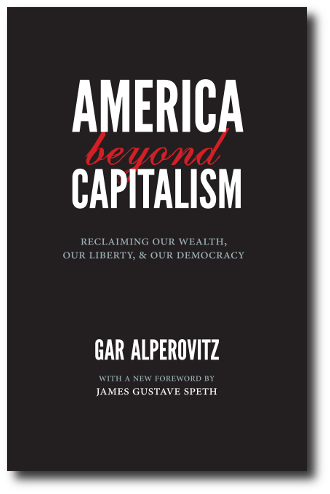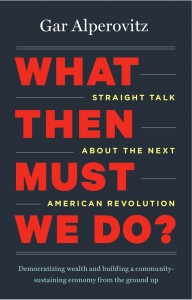(This article first appeared on SHELTERFORCE NO. 149 in the Spring 2007 issue)
From IDAs to comprehensive community wealth-building, the number
of strategies to increase personal and collective assets is growing.
By Gar Alperovitz, Steve Dubb and Ted Howard
In the past decade, individual and collective
asset-building has increasingly become a central goal in the community-
development field. As a result, asset-
building approaches have proliferated:
The most common is the individual
development account (IDA), which builds the financial
assets of low-income individuals
through matched-savings plans offered by community
development groups. But the IDAis only
one example of a growing number of strategies
aimed at increasing both individual wealth and
the collective assets of a community.
In under-funded communities across the
country nonprofits and local governments have
begun to implement more asset-building strategies
for communities, from nonprofit-owned
businesses to new municipal enterprises. The
critical challenge that remains is to integrate the
various wealth-building activities, a step which
could significantly boost both the capacity and
revenue of nonprofits and communities.
New Types of Asset-Building
Many asset-building strategies combine individual
and community wealth-building.
“Community wealth” arises when an institution
uses the wealth or assets it owns to benefit
the community at large. Community land
trusts, for example, do this through homeownership.
A land trust is a locally based nonprofit
that owns land on behalf of the community.
The trust sells houses on its property using a
restricted deed but retains ownership of the
land underneath. The trust and the purchaser
share equity through a formula that allows for
some equity accumulation for the family (although
less than with direct homeownership)
but limits the resale price to preserve permanent
affordability.
A study of the land trust in Burlington, Vt.,
found that the average land-trust homeowner
gained between $5,000 and $8,000 in equity
in about six years, allowing the majority to
“step up” to traditional homeownership. The
equity gain retained by the trust enabled it to
provide affordable housing to future generations—
a type of community wealth of great
significance as public subsidy funds become
more limited. Chicago, Ill., and Irvine, Calif.,
are among the many cities now developing
land trusts. By 2025, Irvine expects to develop
almost 10,000 units of land-trust housing,
which will represent 10 percent of its total
housing. (See “City Hall Steps In,” page 12.)
Collective forms of business ownership are
also thriving across the country. Today, more
than 120 million Americans are members of at
least one cooperative or credit union. Credit
unions alone have assets exceeding $600 billion.
Non-financial cooperatives are also growing.
Retail food cooperatives, if grouped together,
would constitute the fourth largest chain
in the natural-foods industry.
The expansion of employee ownership,
once seen as a radical demand but now commonplace,
is even more impressive.A modest
federal tax credit ($2 billion per year) has encouraged
increasing numbers of retiring owners
to investigate employee stock-ownership
plans (ESOPs). The credit reduces their capital gains
taxes if they sell at least 30 percent of
their enterprises to their employees. Today,
there are more than 10 million employee owners
in ESOPs, up from 250,000 three
decades ago.
The wealth-building importance of ESOPs
is dramatic: The assets owned by employees
in ESOPs are worth an estimated $600 billion—
about $60,000 per employee-owner. In
comparison, the most recently available CFED
survey found that in 2003 the number of participants
in IDA programs totaled roughly
50,000, and the amount of money leveraged in
purchases supported by IDA matches had
reached a relatively modest $168 million.
ESOPs also support community wealth building
in a variety of ways: They provide
stable, well-paying jobs, anchor capital locally
and contribute to a stable economic base that
generates tax revenue and supports public services.
In this age of global capital mobility, when
jobs are moved from America’s cities to South
America or Asia, workers in employee-owned
firms do not vote to ship their own jobs abroad.
A study by the Ohio Employee Ownership
Center at Kent State University found that in
Ohio 58 percent of all conversions to employee
ownership occur because of succession issues,
which arise when a retiring owner needs
to cash out. This pattern seems to hold true
around the country. Because of the impending
retirement of the baby-boom generation, there
is a clear opportunity for many additional conversions.
In the next five years, 30 percent of
family-owned firms are expected to experience
a change in leadership because of retirement
or semi-retirement. Cornell economist
Robert Avery estimates that the nation will experience
a net $10.4 trillion transfer of family owned
business assets by 2040.
The looming threat of not responding to
this opportunity is also clear: Many viable
community businesses will simply be closed
or purchased by large corporations that will
shift operations elsewhere. Local governments
can use policy approaches, such as tax
credits or technical-assistance programs, to
promote employee ownership and take advantage
of this opportunity.
Social enterprises owned by nonprofits are
also expanding in size and impact. As of 2005,
annual revenues of members of the Social Enterprise
Alliance, a trade association founded
only a few years ago, had grown to $1.6 billion,
of which nearly a third ($525 million)
was from earned income. Along with providing
direct benefits, social enterprises build the
assets of nonprofits, making them a more stable
presence in the community and freeing
charitable dollars for other work.
Local and state governments can directly
own businesses that both generate revenue and
provide needed services. Close to 2,000 localities
own their own electric utilities, and many
of these have diversified beyond power production.
According to the American Public
Power Association, as of the end of 2005, 105
municipal utilities provided cable television,
175 leased fiber optic networks, 132 provided
Internet services, 272 offered municipal data
networking, 47 provided long-distance telephone
service and 57 provided local phone
service. The business revenue generated by
such enterprises can be an important source of
income for cash-starved city coffers, and
thereby a source of relief to highly taxed city
residents. Cleveland Magazine reports that
public ownership of Cleveland Public Power
saved city taxpayers $185 million between
1985 and 1996.
Hundreds of cities derive revenue by generating
energy from landfill gas. Riverview,
Mich., recovers 4 million cubic feet of methane
gas daily, contributing 40,000 megawatt-hours
per year toward the city’s residential electricity
needs, with royalties flowing back to the city.
Cities are also generating revenue and providing
services through real-estate ownership.
Boston, seeking to promote urban revitalization,
invested in the Faneuil Hall Marketplace
retail complex in the early 1970s. The development
helped revitalize Boston’s downtown,
and the annual lease revenues the city earned
over the next decade were an estimated 40
percent higher than would have been generated
simply from property taxes on the complex.
Boston’s achievement has inspired city officials
around the country. In many localities,
transit authorities are generating lease income
by developing publicly owned real-estate
assets around transit stations.
Local governments can also direct dollars
they are already spending or investing in ways
that build local assets and community wealth.
Nationwide, public-sector pension-fund assets
total over $2 trillion. Increasingly, a portion of
these funds is being targeted to fill capital gaps
that would otherwise retard local economic
growth. Retirement Systems of Alabama invests
in numerous Alabama-based industries,
including a statewide golf-course network that
has raised tourist revenues while earning a
strong return for the pension fund. CalPERS,
California’s largest employee pension fund,
invests part of its more than $200 billion in
community-investment funds, such as Pacific
Community Ventures, which in turn make
venture-capital investments in local businesses
deemed likely to generate high-wage jobs.
Anchor institutions such as churches, universities,
museums, community foundations
and nonprofit hospitals can support community
wealth-building through their purchasing
and investment policies. Higher education institutions
collectively spend $350 billion a
year, and the total of their endowments now
tops $300 billion. If these organizations focus
even a small amount of their purchasing and
investment decisions on supporting local asset building,
it can make a huge difference. For example,
the University of Pennsylvania increased
its purchasing from local vendors in West
Philadelphia from $20.1 million in 1996 to
$61.6 million in 2003; this helped leverage an
additional $370 million in private investment.
The Role of CDCs
Community development corporations (CDCs)
are major players in asset-based strategies.
They have traditionally anchored capital locally
by promoting homeownership and developing
community-owned and -controlled businesses.
With the increased interest in asset-building
strategies, many have expanded their efforts.
According to the 2006 National Congress for
Community Economic Development (NCCED)
industry survey, the percentage of CDCs offering
IDAs climbed from 9 percent in 1998 to 22
percent in 2005. CDCs also administer micro lending
programs and, as of 2005, had
116,000 loans (valued at $1.5 billion) to microenterprises
on their books. This expansion of
CDC financing programs has helped fuel the
rapid growth of a new type of organization,
the community development financial institution
(CDFI). CDFIs—banks, credit unions,
loan funds and equity funds that have a community
development mission—have become
proficient providers of direct loans, capital and
technical assistance to low-income individuals
and communities.
CDCs are also increasing their involvement
in collective asset-building through business
ownership and investment. NCCED’s 2005 industry
survey estimated that 17 percent of
CDCs have equity investments in businesses
(up from 12 percent in 1998), 21 percent operate
businesses and 24 percent own businesses.
“CDCs have come a long way since their
origin in the ’60s as an outgrowth of the civil
rights movement and the War on Poverty,” said
Ron Phillips in a January 2007 Community-
Wealth.org e-newsletter interview. Phillips is
the CEO of Coastal Enterprises, Inc., a
statewide CDC and CDFI in Maine. Phillips
went on to note that, “community-based development
and finance entities number over
4,000 today, managing billions in housing,
real-estate and small-business assets and investments.”
The growth has indeed been remarkable.
Three decades ago, there were roughly
200 CDCs, and the term “CDFI” had yet to be
invented. As of 2005, there were 4,600 CDCs,
and the CDFI industry is now poised to top $20
billion in assets.
Increasingly, CDCs and CDFIs, as well as
some forward-thinking community foundations,
have sought ways to expand their “asset related”
work across a range of sectors. This
has helped facilitate what Heather McCulloch,
founder of Asset Building Strategies, calls a
developing continuum of asset-building efforts—
beginning at the individual level and
moving steadily wider to encompass various
forms of community-benefiting enterprises.
McCulloch is working with a group in San
Francisco’s Mission District to develop a multifaceted
wealth-building strategy. The program
includes family and individual programs (such
as IDAs), efforts to develop common assets
through shared-equity housing (such as community
land trusts or limited-equity cooperatives)
and funds to develop resident-owned
businesses (such as worker cooperatives) and
enterprises in which ownership is restricted to
community members. (The community-owned
enterprise model echoes the Green Bay Packers
franchise in the National Football League,
which has been owned by the residents of
Green Bay,Wis., for more than 80 years.)
One of the most innovative integrated efforts
in the country is the Market Creek Plaza
project in San Diego. Market Creek is a $65
million commercial and cultural complex, anchored
by a shopping center. It is located in
the Diamond neighborhood in southeastern
San Diego and was developed by the Jacobs
Foundation. Drawing on the results of an extensive
public planning process, the foundation
created a project that consciously links
individual and collective asset-development.
On the one hand, individuals were able to become
direct owners and accumulate assets by
purchasing shares in the shopping center
through a limited, initial public offering restricted
to community members. Twenty percent
of the equity is owned this way. A new
neighborhood foundation also owns 20 percent
of the shopping center, which it will use
to provide future community wealth-building
efforts with a sustainable source of funding.
The Jacobs Foundation, which currently
retains 60-percent ownership, intends to turn
over full ownership of the project to the
community owners by 2018.
Looking Forward
Asset-based strategies can be particularly appealing
in a time of ever-tightening budgets,
because most of them do not rely on large
public expenditures. Even those that do require
some government spending can capitalize
on the broad political appeal of promoting
investment and creating assets.
There is evidence that asset-based strategies
can achieve broad bipartisan political support.
At a 2006 policy roundtable sponsored by the
Democracy Collaborative of the University of
Maryland and the Aspen Institute, a range of
asset-building and community wealth-building
strategies won support from liberal, moderate
and conservative participants—including
Robert Borosage, co-director of the liberal
Campaign for America’s Future; William Galston,
a senior fellow at the Brookings Institution
and a centrist “New Democrat” adviser in
the Clinton White House; and Stephen Goldsmith,
former Republican mayor of Indianapolis
and George W. Bush’s domestic
policy adviser in his 2000 campaign.
But local groups need to coordinate their
efforts to make the most of this political promise.
Often groups working in the same city
know little about the asset-building efforts of
others. Fortunately, attempts to break down
the “silo” problem have begun. Policy Link,
based in Oakland, Calif., has undertaken various
regional equity initiatives around the
country. Statewide asset-policy coalitions are
growing in a number of states, including Alaska,
California, Hawaii, Illinois, Michigan and
Pennsylvania.
The Democracy Collaborative hosted two
community wealth-building roundtables in the
fall of 2006 in an effort to encourage more cooperation.
In Scranton, Pa., 30 business, labor,
community and nonprofit leaders came together, including the mayor, the head of the city
council and two college presidents. Scranton
has lost a significant percentage of its population
in recent decades due to a lack of employment
opportunities, so using ESOPs as a strategy
for job retention garnered significant interest.
Participants were also very interested in the
role the city’s major public institutions could
play by targeting their procurement locally.
The second roundtable took place in Cleveland,
Ohio. Approximately 50 community
leaders representing all aspects of local asset
development gathered for a day and a half.
Among others, Cleveland’s newly hired economic
development director showed strong
interest in “across the board” strategies and
encouraged conference participants to work
with his office to submit proposals that could
be incorporated into the city’s strategic plan.
Following the event, participants launched
plans to further cross-sectoral collaboration by
making employee-ownership information
more available to traditional community development
groups and by incorporating asset building
goals into negotiated community
benefit agreements with local developers.
A Historic Transition
In a 2003 article in Shelterforce, Michael
Sherraden, widely acknowledged as the
founder of the IDA concept, wrote that we are
“very likely [in the midst of] a historic transition
toward asset accounts as a main social
policy instrument—a transition from Social
Welfare State to Social Investment State.” We
agree. What is striking is that such a strategy
promises to move well beyond IDAs and other
family and individual wealth-building approaches
to encompass a wider range of community
wealth-building strategies. If the
promising experiments at integration continue,
and if the political possibilities of these
strategies are realized, we may soon see a significant
shift toward broad-spectrum asset based
social policy across the country.
 AMERICA BEYOND CAPITALISM
AMERICA BEYOND CAPITALISM



 Agenda
Agenda  Posterboard
Posterboard 